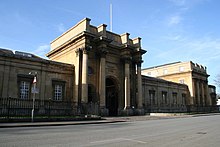Oxford University Press
| Oxford University Press
|
|
|---|---|
| legal form | |
| founding | 1586 |
| Seat | Oxford |
| Number of employees | 6,000 |
| Branch | publishing company |
Oxford University Press ( OUP ) is the largest university publisher in the world and part of Oxford University in England . The publisher has non-profit status and transfers 30% of annual profits, at least £ 12 million , to the university.
history
Oxford University Press publishes a wide variety of academic papers, specialist and textbooks and is editor of the Oxford English Dictionary . Many products are now also available in electronic form.
In 1586 Oxford University was granted the rights to print books. OUP rose to become the largest publisher in the world after the publisher received the publishing rights to the King James Bible in the 17th century .
The publisher's international expansion began in 1896 with the opening of a sales office in the United States . Today Oxford University Press publishes around 4,500 new books a year and employs around 4,800 people in more than 50 countries.
The history of the publisher is presented in its own museum, which is located on Great Clarendon Street in Oxford. Among other things, selected prints and a printing press from the 19th century can be viewed there. Entry to the museum is free.
Every book published by Oxford University Press has an ISBN that begins with the digits 0-19. OUP is one of the few publishers worldwide that has two-digit identification numbers.
Oxford World's Classics is an imprint from the publisher.
Clarendon Press
Some of the books published by Oxford University Press appear under the label "Oxford: At the Clarendon Press". It was named after the English statesman Edward Clarendon (1609–1674).
Oxford India Paper
Oxford India Paper is a thin printing paper . It is also called Bible paper because it was used for the Oxford University Press Bible editions.
Web links
- Official homepage of Oxford University Press
- Online dictionaries:

